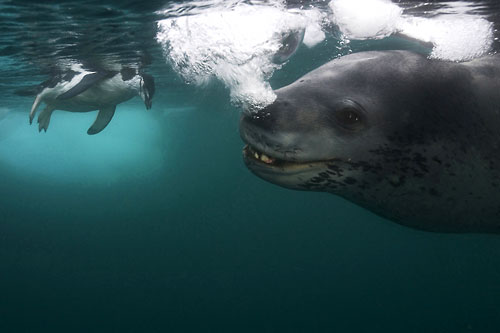
First Place
Paul Nicklen
"Leopard Seal " A leopard seal was frustrated that I would not accept her offered penguin. Blowing bubbles is a threat display but she never appeared aggressive. Leopard seals have killed a human and attacked others. I wanted to prove that all leopard seals are not dangerous. The death of the scientist was an isolated and unfortunate incident, I believe.
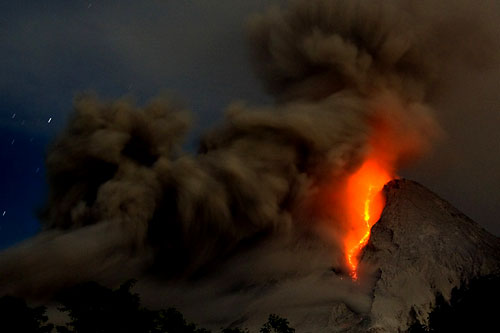
Second Place
Kemal Jufri
"Turbulent Eruptions" Indonesia's Mount Merapi erupts, spewing a huge burning clouds of gas and blazing lava. Merapi, located on the Indonesian island of Java is one of the world's most active and dangerous volcano which has produced more pyroclastic flows than any other volcano in the world.
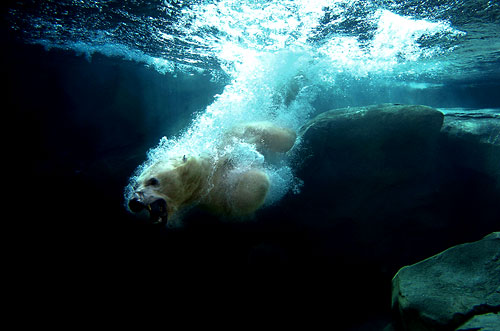
Third Place
Jeffrey F. Bill
"Polar Bear Plunge" Enjoying this winter's mild temperatures either by taking a 'polar bear plunge,' basking in the sun, or gazing across the plain - it's business as usual for it's residents at the Maryland Zoo in Baltimore. Established in 1876, it is the 3rd oldest zoo in the country and averages over 400,000 visitors annually.
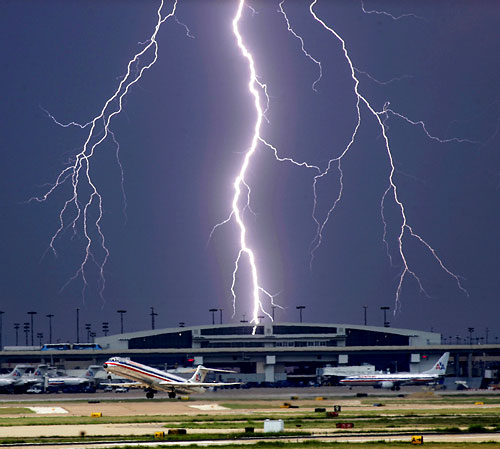
Award of Excellence
Tom Fox
"Last Flight Out" A bolt of lightning strikes beyond the terminals as an American Airlines jet takes off from Dallas/Fort Worth International Airport, as an approaching storm passes by.
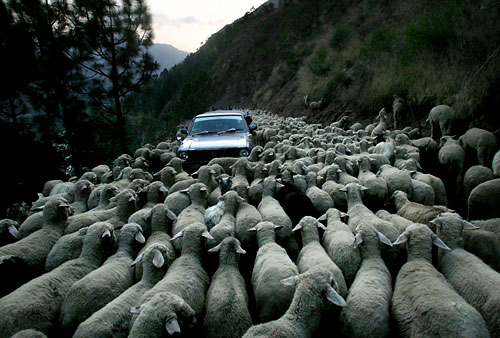
Award of Excellence
David Guttenfelder
A large flock of sheep blocks a once landslide-covered road in the mountains of the Kashmir region of Pakistan near the village Sharian Sept. 23, 2006. In Muzaffarabad, the wrecked capital of Pakistan's portion of Kashmir, life has assumed a degree of normality after a 7.6-magnitude earthquake killed more than 80,00 people. But despite US6.7 billion in aid pledges, reconstruction has got off to a slow start in these destroyed regions of Pakistan and India.
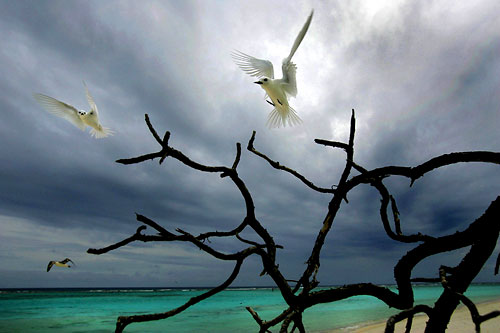
Award of Excellence
Rick Loomis
"Fairy in Flight" Midway Atoll is a major rookery for white terns, also known as fairy terns. In a landmark effort for habitat preservation, President Bush recently declared the atoll part of the Northwestern Hawaiian Islands National Monument, the world's largest marine preserve. While many applaude the effort, critics say that its too little, too late for much of the ocean environment.
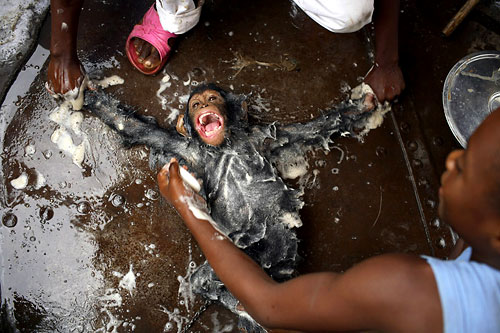
Award of Excellence
Per-Anders Pettersson
"A CHIMPANZE BEING WASHED" Crew members wash Dola, a chimpanzee, that they bought for US$ 25, while waiting for their boat to leave the Kisangani port for the capital Kinshasa on March 4, 2006 in Kisangani, in Congo, DRC. Dola died a few days later from an unknown disease. Many animals are taken to Kinshasa and sold as pets or for the meat. The Congo River is a lifeline for millions of people, who depend on it for transport and trade. The journey from Kisangani to Kinshasa is about 1750 kilometers, and it takes from 3-7 weeks on the river, depending on the boat. During the Mobuto era, big boats run by the state company ONATRA dominated the traffic on the river. These boats had cabins and restaurants etc. All the boats are now private and are mainly barges that transport goods. The crews sell tickets to passengers who travel in very bad conditions, mixing passengers with animals, goods and only about two toilets for five hundred passengers. The conditions on the boats often resemble conditions in a refugee camp. Congo is planning to hold general elections by July 2006, the first democratic elections in forty years.
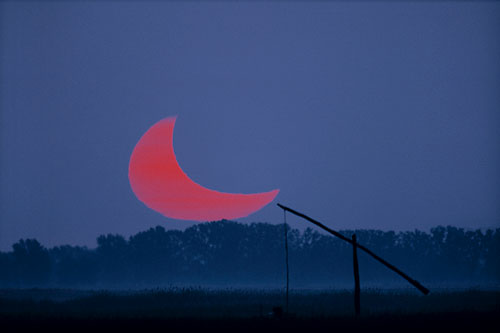
Award of Excellence
Milan Radisics Award of Excellence
"Solar Eclipse from Apajpuszta" Capturing this image of a solar eclipse involved thorough preparation and a little luck for nature photographer Milᮊ Radisics. He began by creating and studying digital replications of the phenomenon, and then took to the road in search of an ideal location from which to shoot. On the morning of the eclipse Radisics set up in Apajpuszta, near Budapest, but to his great disappointment, the horizon appeared impenetrably cloudy. Suddenly, as luck would have it, the tip of the sun's red crescent emerged from the haze, and he got his shot. 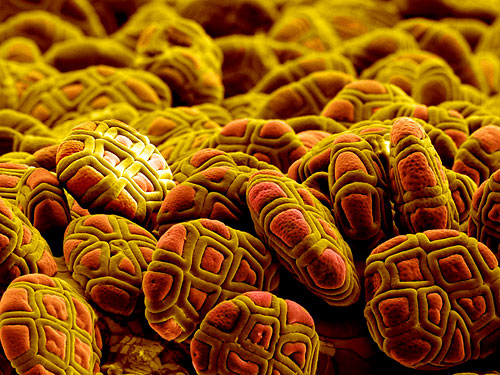
Bob Sacha
One of the most widespread allergens that set off people to sneezing and wheezing in the allergy season. Each spring, summer, and fall, tiny particles are released from trees, weeds, and grasses. These particles, known as pollen, hitch rides on currents of air. Although their mission is to fertilize parts of other plants, many never reach their targets. Instead, they enter human noses and throats, triggering a type of seasonal allergic rhinitis called pollen allergy, which many people know as hay fever or rose fever (depending on the season in which the symptoms occur). Of all the things that can cause an allergy, pollen is one of the most widespread. Many of the foods, drugs, or animals that cause allergies can be avoided to a great extent; even insects and household dust are escapable. Short of staying indoors when the pollen count is high -- and even that may not help -- there is no easy way to evade windborne pollen. People with pollen allergies often develop sensitivities to other troublemakers that are present all year, such as dust mites. For these allergy sufferers, the 'sneezin' season' has no limit. Year-round airborne allergens cause perennial allergic rhinitis, as distinguished from seasonal allergic rhinitis. Plants produce microscopic round or oval pollen grains to reproduce. In some species, the plant uses the pollen from its own flowers to fertilize itself. Other types must be cross-pollinated; that is, in order for fertilization to take place and seeds to form, pollen must be transferred from the flower of one plant to that of another plant of the same species. Insects do this job for certain flowering plants, while other plants rely on wind transport. The types of pollen that most commonly cause allergic reactions are produced by the plain-looking plants (trees, grasses, and weeds) that do not have showy flowers. These plants manufacture small, light, dry pollen granules that are custom-made for wind transport.



